
The Komondor, also known as the Hungarian sheepdog, is a large, white-coloured Hungarian breed of livestock guardian dog with a long, corded coat.
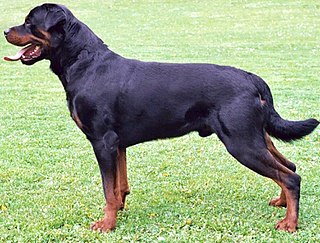
The Rottweiler is a breed of domestic dog, regarded as medium-to-large or large. The dogs were known in German as Rottweiler Metzgerhund, meaning Rottweil butchers' dogs, because their main use was to herd livestock and pull carts laden with butchered meat to market. This continued until the mid-19th century when railways replaced droving. Although still used to herd stock in many parts of the world, Rottweilers are now also used as search and rescue dogs, guard dogs, and police dogs.

The Belgian Shepherd, also known as the Belgian Sheepdog or the Chien de Berger Belge, is a Belgian breed of herding dog of medium size. It is bred in four distinct varieties based on coat type and colour: the long-haired black Groenendael; the rough-haired fawn Laekenois; the short-haired fawn Malinois, and the long-haired fawn Tervuren. The American Kennel Club considers the four varieties to be separate breeds.
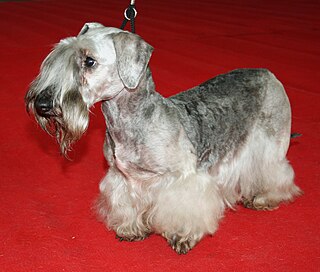
The Cesky Terrier is a small terrier type dog originating in Czechoslovakia.

The Havanese, a bichon-type dog, is the national dog of Cuba, developed from the now extinct Blanquito de la Habana. The Blanquito descended from the also now-extinct Bichón Tenerife. It is believed that the Blanquito was eventually cross-bred with other bichon types, including the poodle, to create what is now known as the Havanese. They are sometimes referred to as "Havana Silk Dogs", but this is a separate breed, which has been bred to meet the original Cuban standards.

The Cane Corso is an Italian breed of mastiff. It is usually kept as a companion dog or guard dog; it may also be used to protect livestock. In the past it was used for hunting large game, and also to herd cattle.

The Stabyhoun, or Stabijhoun or Stabij, is one of the rarest dog breeds in the world. It hails from the Dutch province of Friesland; its origins lie in the forested region of eastern and southeastern Friesland. The breed has been mentioned in Dutch literature dating back to the early 1800s, but it was not until the 1960s that the breed became known outside its native province; the first Stabyhouns left the Netherlands some decades later, in the 2000s. The name Stabijhoun translates roughly to "stand by [me] dog". The dog is considered a Dutch national treasure. Today, there are only a few thousand Stabyhouns worldwide.

The Olde English Bulldogge is an American dog breed, recognized by the United Kennel Club (UKC) in January 2014. The breed is listed in the UKC Guardian Dog Group. Five years prior to UKC recognition, the breed was registered by the former Canine Developmental, Health and Performance Registry (CDHPR), a privately held business located in Kalamazoo, Michigan. In the early 2000s, CDHPR had been working with the UKC under a unique agreement to develop breeding plans and strategies in an effort to produce improved breeds of dogs that would be accepted as purebred and, therefore, eligible for UKC registration.

The Estrela Mountain Dog is a large breed of dog from the Estrela Mountains of Portugal bred to guard herds and homesteads. It is "one of the oldest breeds in the Iberian Peninsula."

A Dunker, also known as the Norwegian Hound, is a medium-sized breed of dog from Norway. It was bred by Wilhelm Dunker to be a scenthound by crossing a Russian Harlequin Hound with dependable Norwegian scent hounds.

The Bavarian Mountain Hound is a breed of dog from Germany. As a scent hound, it has been used in Germany since the early 20th century to trail wounded game. It appears to be a cross between a Bloodhound, Labrador Retriever, Great Dane, German Shepherd, Beauceron, Rhodesian Ridgeback, and a Hanover Hound. This dog needs plenty of exercise and if not given the correct mental and physical stimulation can be prone to depression and sometimes become destructive, though having all these traits they are very kind loving dogs that are great with kids and adults. These dogs tend to be vocal dogs with stubborn attitudes yet still obedient and one of the most intelligent of the hound breeds.

The Shropshire breed of domestic sheep originated from the hills of Shropshire, and North Staffordshire, England, during the 1840s. The breeders in the area used the local horned black-faced sheep and crossed them with a few breeds of white-faced sheep. This produced a medium-sized polled (hornless) sheep that produced good wool and meat. In 1855 the first Shropshires were imported into the United States (Virginia). This breed is raised primarily for meat.

The KuchiDog, also known as the AfghanShepherd, is an Afghan livestock guardian dog, taking its name from the Kuchi people of Afghanistan. It is a working dog following the nomads, protecting caravans and flocks of sheep, goats, camels and other livestock from wolves, big cats and thieves.

The Taiwan Dog is a breed of small or medium dog indigenous to Taiwan. These dogs are also known as the Formosan Mountain Dog. They are well-adapted to the uneven and thickly forested terrain of Taiwan, having become a semi-wild breed prior to the arrival of several colonial reigns and foreign powers. Notwithstanding these adaptations, Formosans retained the potential to be trained and are now used as hunting dogs, guard dogs, stunt dogs, rescue dogs, or simply as companions. Formosans are classified into one medium type and two small types.

The Romanian Bucovina Shepherd Dog is a breed of livestock guardian dogs native to the historical Bukovina (Bucovina) region. The breed is closely related to other livestock guardian breeds of the region, such as the Greek Shepherd, Tornjak, or Šarplaninac. There are four Romanian shepherd dog breeds: the Romanian Mioritic Shepherd Dog, the Carpathian Shepherd Dog, the Romanian Raven Shepherd Dog, and the Bucovina Shepherd Dog. In the FCI, this particular breed is officially dubbed the "Romanian Bucovina Shepherd".

The Slovak Cuvac is a Slovak breed of dog, bred for use as a livestock guard dog. This breed—also known as Slovensky Cuvac, Slovak Chuvach, Tatransky Cuvac and Slovensky Kuvac—is closely related to the Hungarian Kuvasz. The alternate German and English spelling Tchouvatch reflects the pronunciation: chew-votch( čuvati - in serbocroatian language - guarding). The breed is recognised under sponsorship from Slovakia by the Fédération Cynologique Internationale with the name Slovenský čuvač. Despite the multiple renderings in English, these refer to only one breed. The United Kennel Club in the US uses the English version of the name Slovak Cuvac.

The Karst Shepherd is a breed of dog of the livestock guardian type, originating in Slovenia. This breed is recognised by the Fédération Cynologique Internationale.
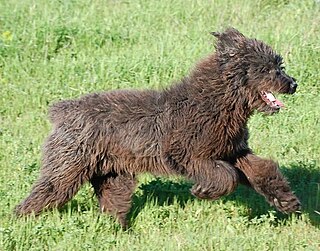
The Sardinian Shepherd Dog or Fonni's Dog is an ancient landrace breed of Sardinian dog used as a herding, catching, and livestock guardian dog.
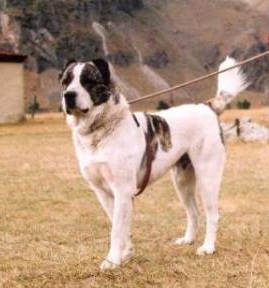
The Georgian Shepherd, also known as Georgian Mountain Dog, is a breed of guard dog and livestock guardian dog from the Georgian Caucasus.
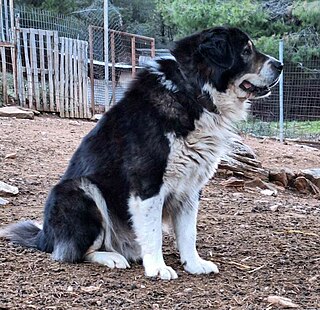
The Greek Shepherd or Greek Sheepdog is a breed of livestock guardian dog from Greece. Thought to be ancient in origin, the Greek Shepherd is very closely related to livestock guardian dog breeds from neighbouring countries; it is believed that some dogs are simultaneously claimed to be other breeds as they migrate annually across national borders with the flocks they protect in search seasonal pastures.






















